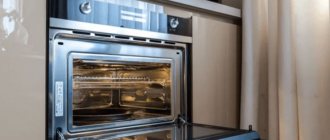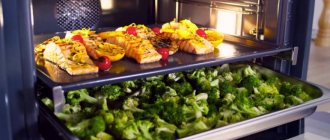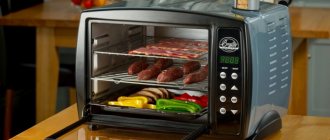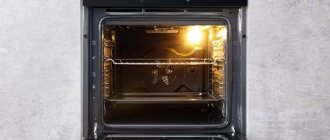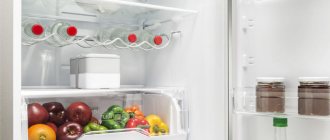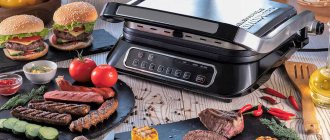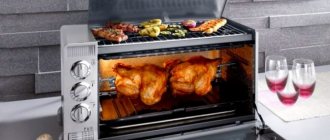Built-in ovens steel an excellent alternative to unsightly kitchen stoves coated with white enamel.
Every year, choosing an electric oven becomes more difficult, as the equipment is constantly acquiring new functions.
To choose the right built-in oven, future buyers need to study its design options and design features.
To choose a reliable and proven electric oven, we suggest that you familiarize yourself with the most popular models in terms of price and quality.
The table contains models that have received the highest reviews on the Yandex.Market service.
| Place | Model | Price |
| Inexpensive segment up to 25,000 rubles | ||
| #1 | Electrolux EZB 52410 AK | |
| #2 | GEFEST YES 602-01 N1 | |
| #3 | Simfer B6EW16011 | |
| #4 | Bosch HBF534EB0R | |
| #5 | Fornelli FEA 45 Corrente BL | |
| Middle segment 25,000-50,000 rubles | ||
| #1 | Weissgauff OE 445 X | |
| #2 | Gorenje BO 7530 CLB | |
| #3 | Bosch HBG634BS1 | |
| #4 | Bosch HBG337YB0R | |
| #5 | Hotpoint-Ariston FI7 871 SC IX | |
| Premium from 50,000 rubles | ||
| #1 | Bosch HBG634BS1 | |
| #2 | Bosch HBG633BB1 | |
| #3 | NEFF B17CR22N1 | |
| #4 | MAUNFELD MEOH 6711B | |
| #5 | Smeg SF6922XPZE1 | |
Page navigation:
Selecting the type of design - independent and dependent built-in ovens
Most ovens produced today are independent household appliances. They have their own control system, and their operation is in no way connected with the operation of other kitchen units. For many users, this is a huge advantage, because such an oven can be placed anywhere in the kitchen (for example, in a column cabinet for built-in appliances) at the height that is most convenient for you.
There is an alternative option - a dependent oven. This type is sold complete with a hob and has a common control panel located on the front surface of the oven. If you initially plan to buy both kitchen units, then purchasing such a set is a real chance for you to save money, because it will cost you significantly less than an oven and hob purchased separately.
In addition, the elements of the kit are usually made in the same style, which means you don’t have to keep in mind the issue of compatibility of equipment with each other in design.
Some manufacturers leave the buyer a choice, producing several models of hobs that are compatible with a given oven model. This is where the advantages of dependent ovens end; what follows, alas, is a whole series of disadvantages.
- Firstly, the combined control panel often looks somewhat overloaded with control elements.
- Secondly, there are restrictions on the placement of the oven: the hob and oven must be located in close proximity to each other, and since the first is always installed at a certain level, you will inevitably only be able to access the second by bending over.
- The third and most significant disadvantage of dependent kits is that if for some reason your oven fails, you will most likely lose the ability to use the hob.
Installation type: independent or dependent cabinet
Ovens are divided into dependent and independent.
The dependent cabinet has a common control panel with the hob and is installed under it.
This kit is the same good gas stove, but only built-in.
Keep in mind! A dependent set of electric bottom and gas top is also possible, but there are too few such models on the market.
An independent oven has its own control panel and is in no way dependent on other kitchen appliances.
Typically, such a cabinet is installed in a pencil case along with a microwave.
Also, the independence of the oven allows you to install a hob with any number of burners in the kitchen.
Oven dimensions and installation rules
There are several standard sizes of ovens. Both the width and height of a full-size (standard) oven are 60 cm. Compact ovens with the same width are slightly lower - 40-45 cm, and narrow ovens, on the contrary, with a standard height have a smaller width - only 45 cm. Compact and especially narrow ovens - ideal for small kitchens.
There are also models on the market with a width increased to 90 cm; their height, like that of compact ovens, is 45 cm. The depth of all of the above types of ovens is approximately the same - 55-60 cm, because this parameter is determined by the depth of the kitchen unit, and here there is a standard dictated by the question of convenience.
The answer to the question of which built-in electric oven is best to choose primarily depends on the size of the room you have. Most of our compatriots still have incredibly tiny kitchens, where the struggle is for every free centimeter of space. And since you want to equip such a kitchen with all the necessary appliances, you have to sacrifice something, in this case, the size of the oven. However, this will not necessarily be a sacrifice: if you have a small family and, therefore, you cook a little, then there is simply no need to chase a large-volume model.
We consider it necessary to warn you against one fairly common mistake. If, having read the installation dimensions on the price tag of the model you like, you are happily rubbing your hands at the thought that you will be able to squeeze this oven into the niche provided for it, we hasten to disappoint you - this oven is not suitable for you, and you need to look for another option.
The word “squeeze” is unacceptable for embedded technology. The oven is a powerful source of heat, which means that furniture that is in close contact with its walls will also heat up. Regular overheating of the latter will inevitably cause gradual destruction (the worst outcome – fire – cannot be ruled out). Therefore, when building heating equipment into furniture, ventilation gaps should be provided between their walls.
The distance between the oven and the side walls of the niche in which it will be built must be at least 5 mm on each side, and from the bottom of the oven to the “floor” of the niche - at least 85 mm. The rear walls must be separated by at least 40 mm of free space (often the rear wall of the niche is simply removed).
The above figures are some general recommendations. Different models may have their own installation features, and you should primarily focus on the information contained in the instruction manual.
Types of electric ovens
The domestic market of household appliances offers a huge range of electric ovens, which are divided into several types.
First of all, electric ovens are divided according to their location:
Such models are bulky in size and therefore take up a lot of space. As a rule, they consist of an oven and a hob with 3 or more burners
More compact ovens that are mounted in a special niche of the kitchen unit. They have a nice design and simple controls
The most compact electric ovens. Thanks to its small size, it can be installed in any area of the table or other kitchen furniture.
Electric ovens are also divided by type of control:
This category includes ovens combined with a hob. In addition to the electric oven, the design includes 3 or 4 burners of different diameters. The device has a common control panel - from 5 regulators
Such models have their own control panel, which is located on the front side of the oven.
Oven cleaning methods
Many people love to create various culinary masterpieces in ovens; almost everyone loves to eat these freshly baked dishes, but no one is eager to wash the grease-splattered oven walls. Modern technologies can significantly facilitate this process, but ovens in which these technologies are implemented are much more expensive. Which oven cleaning method should I choose and is it worth overpaying for it?
Traditional.
Inexpensive models, the inner walls of which are covered with ordinary heat-resistant enamel, require traditional cleaning - manually, using a sponge and detergent.
It should be noted that if you do not accumulate dirt for years, but clean it regularly, after each cooking, then it is not so difficult.
Catalytic.
Most models in the mid-price segment implement a catalytic cleaning method. The walls of the working chamber in such ovens (often not all of them, but only the back one, as it is the most contaminated) are covered with a special enamel containing a catalyst. The latter promotes the breakdown of fat into water and carbon; this occurs at elevated temperatures, directly during the cooking process. When the oven has cooled, all that remains is to remove the soot accumulated as a result of the catalytic process with a damp sponge. The disadvantage of this method is a decrease in the activity of the catalyst after 5-7 years of active operation of the oven.
Pyrolytic.
Premium models often use a more effective cleaning method - pyrolytic. When activated, the oven heats up to 500°C; at such a high temperature, fat simply burns. After such self-cleaning, it is enough to wipe the oven walls with a damp cloth or sponge to remove a small amount of the pyrolysis product - soot. This method contributes to additional energy consumption, and the ovens in which it is implemented are the most expensive, but despite this, pyrolysis is very popular among consumers.
Steam-water.
In recent years, another cleaning method has gained popularity - steam-water. It is quite simple and economical, but at the same time quite effective. Place a baking tray with a small amount of water in the oven and activate the cleaning mode. The steam generated as a result of heating the liquid softens contaminants on the walls of the working chamber, and they are easily removed mechanically.
Even owners of the cheapest ovens can use this method, because in order to start the steam generation process, it is not at all necessary to have a special button on the control panel - you just need to heat the working chamber to 70-90°C.
Basic criteria for choosing a good electric oven
Power
Can reach 4 kW. On the one hand, high power contributes to rapid heating, on the other hand, you need complete confidence in the reliability of the electrical wiring. The best option is ovens with improved energy efficiency (class A or higher). They maintain maximum functionality with relatively low energy consumption.
Size
This one is simple. The dimensions of the oven must correspond to the chosen installation location. Compact built-in cabinets (45 cm high) usually cost more than their standard counterparts, but they save usable space and are often combined devices with additional functions.
Advanced Heating Modes
- Convection is a ventilation system that ensures uniform baking of the product due to all-round heating with hot air;
- 3D heating – to optimize heat distribution, a fan and a ring type heater are used on the rear wall. More advanced 4D heating provides efficient cooking on 4 or even 5 levels without mixing flavors;
- Vario grill large and small – you can choose depending on the portion size;
- Special modes – defrosting, drying, heating dishes, maintaining temperature, etc.
Additional features and accessories
The capabilities of ovens can be expanded by adding microwave, steam, or both functions. A nice bonus may be the presence of a temperature probe, readiness probe, and telescopic guides.
Self-cleaning oven
- Pyrolytic . A special mode in which the oven is heated to a temperature close to 500°C. Grease and dirt completely burn out and fall out in the form of ash, which can be easily removed with a rag or soft brush;
An important nuance: pyrolytic enamel is a smooth and durable coating in the oven that can withstand very high temperatures. But the presence of such enamel in some models does not necessarily mean that pyrolytic self-cleaning is also supported. Be careful.
- Catalytic . During cooking, fat falls on a special porous surface with an oxidation catalyst and is destroyed during the heating process, splitting into water and carbon. Soot particles can be easily removed with a cloth;
- The hydrolysis method cannot be called self-cleaning, since softening contaminants with steam helps a lot, but it does not replace manual scrubbing of surfaces. The smoother and finely porous the enamel, the easier it is to clean.
Control System Selection
The ease of use of an oven is largely determined by the way its control system is implemented. There are two options here - electromechanical and electronic control.
The presence of an electromechanical control unit significantly reduces the cost of the unit, but its main advantage is its simplicity. Even if you are not limited in funds, but are purchasing appliances for one of your elderly relatives, when deciding which built-in electric oven to choose - with electromechanical or electronic control, preference should be given to the first: older people, as a rule, have difficulty using communication with modern electronics.
The electromechanical control unit is represented by three rotary switches familiar to everyone: one is designed to set the temperature, the second - a timer - is necessary to control the operating time of the oven, and with the help of the third, the heating mode is selected. Sometimes rotary switches are made recessed into the body of the device, but this does not make any fundamental changes in their functioning, but only simplifies the process of cleaning the panel from dirt.
In ovens with electronic control, all necessary operating parameters are set using buttons or, increasingly, touch fields. Typically, electronic control provides a special display that displays information about the selected mode, temperature, cooking time, etc.
Today you can find models with fairly large touch color displays. The latter do not simply display information about the operation of the oven, but visualize the process of “communication” between the user and it. Controlling such equipment is reminiscent of controlling modern digital gadgets - with “flipping through” menu pages, selecting the desired items by touching the corresponding icons on the display, etc. If you belong to the category of people who are ready to spend any amount of money in order to own the most “advanced” equipment, then you can even look for an oven that allows you to download various data via a USB port, including recipes and photographs of ready-made dishes - today there are such .
The electronic control system not only expands the capabilities of the oven, allowing you to implement various automatic cycles, set on/off times, and more accurately control time and temperature. It provides a different level of ease of use of household appliances. But in addition to its high cost, electronics have another significant drawback - the likelihood of failure is much higher than that of electromechanics.
Rating of the TOP 20 best electric ovens of 2021
| Place | Name | Price |
| TOP 5 best built-in electric ovens in price/quality ratio for 2021 | ||
| 1 | Electrolux EZB 52410 AK | Find out the price |
| 2 | Hotpoint-Ariston FI7 861 SH BL | Find out the price |
| 3 | DARINA 1V5 BDE111 705 B | Find out the price |
| 4 | Bosch HBG634BS1 | Find out the price |
| 5 | Electrolux EZB 52410 AW | Find out the price |
| TOP 5 best electric ovens with microwave | ||
| 1 | Bosch HMG636NS1 | Find out the price |
| 2 | Midea AF944EZ8-SS | Find out the price |
| 3 | Bosch CMG636BS1 | Find out the price |
| 4 | Bosch CMG636BB1 | Find out the price |
| 5 | MAUNFELD MCMO.44.9GI | Find out the price |
| TOP 5 best electric convection ovens | ||
| 1 | Weissgauff EOV 19 MB | Find out the price |
| 2 | Electrolux EZB 52430 AX | Find out the price |
| 3 | DARINA 1U BDE111 707 W | Find out the price |
| 4 | Bosch HBG634BW1 | Find out the price |
| 5 | Weissgauff OE 445 X | Find out the price |
| TOP 5 best electric ovens with added steam | ||
| 1 | Hotpoint-Ariston FA5S 841 J IX | Find out the price |
| 2 | Electrolux OKD6P71X | Find out the price |
| 3 | Hotpoint-Ariston FA4S 841 J IX | Find out the price |
| 4 | Bosch HRG656XS2 | Find out the price |
| 5 | Hotpoint-Ariston FA4S 842 J IX | Find out the price |
Deciding on culinary functionality
Most modern ovens are multifunctional devices. What your oven can do determines how much you can realize your culinary potential.
Heating modes
Cooking different foods requires different temperatures and different heating rates. It follows from this that the more heating modes an oven has, the more varied the list of dishes that you can cook in it will be, the more opportunities you will have for various culinary experiments. Budget electric ovens, as a rule, have top, bottom and combined (top + bottom) heating, as well as a grill mode.
In more expensive models, convection modes are added to the classic heating modes. On the back wall of such ovens there is a fan around which a ring heating element is placed. The fan promotes rapid and uniform distribution of heated air throughout the working chamber.
Additional modes
Electronically controlled ovens often have a number of additional modes that significantly expand the functionality of the device. The presence of a convection fan allows you to implement a gentle defrosting mode of food: the heating elements do not turn on in this mode, and the fan circulates air at room temperature throughout the chamber.
The “Stewing” and “Simmering” programs are designed for slow cooking of products at relatively low temperatures, which helps to maximize the preservation of nutrients in them. The “Fermentation” mode can be used to prepare yogurt at home, rise yeast dough, etc.
Steamer function
Some modern oven models have a steam mode. In most cases, this is not steaming, but rather a symbiosis of steam and heat treatment of products. However, there are ovens on sale with a special steam generator design - these can be used as classic steamers.
Microwave module
An electric oven can be equipped with a built-in microwave module. As a result, you get two appliances in one, which can be used as both an oven and a microwave. Moreover, if you wish, you can combine conventional heating with microwave heating, which can significantly reduce cooking time.
Automatic programs
Automatic programs built into the memory of an electronically controlled oven will help to significantly simplify the process of preparing various dishes. The user just needs to indicate the type of product (meat, fish, vegetables, etc.), select one of the types of dishes offered to him to choose from that can be prepared from this product, and enter the weight of the product.
Then the oven operates on its own: based on the algorithms stored in its memory, it selects the temperature mode and determines the process time, and after some time you get a ready-made dinner. The number of preinstalled automatic programs varies from model to model, but can reach several dozen. Some modern premium ovens allow the user to update the software by loading new auto programs in addition to existing ones, as well as save their own cooking algorithms.
Skewer
If you often bake whole poultry or large pieces of meat as the main course of a holiday dinner, a spit will come in handy. A spit rotating from a specially designed electric drive will help to heat the product evenly, making your signature dish even more tasty and attractive.
However, if your oven has a convection heating mode, then you can refuse the grill. A fan will also do an excellent job of its function: in this case, it is not the food that will rotate in the hot air, but the hot air around the food - the effect will be the same, which means that the meat on the grill will be cooked no worse than on a spit.
Temperature probe
When baking large pieces of meat, it can be difficult to assess how much the temperature inside the piece differs from the air temperature in the cooking chamber, and therefore to make an assumption about the degree of readiness of the product. A temperature probe will come to your aid - a thermometer that measures the temperature inside the product being prepared. When the required temperature is reached, the temperature probe will “notify” the control system about this, and it, in turn, will notify the user about this or perform an automatic shutdown.
Oven with warming function
- Oven modes
- Quickly preheat the oven
- Oven functions
Basically, all ovens are very functional. heating function today and whether there is such a thing at all.
In an electric oven, a combination of a mode such as a ring and bottom heater with a fan can be used as a function for heating food . This one is also designed for defrosting food. All ovens have a mode such as a lower heating element; it is used as the main one. But modes such as a fan or a ring heater are present in electric ovens, depending on the model. A conventional static oven includes the main modes - top and bottom heating elements and can also include a grill.
Using the fan function, the oven is converted from a static oven to a multifunctional one. The fan changes everything in the oven, with its help new additional modes and functions appear.
An oven with a heating function is a multifunctional oven.
The following functions are almost always present with the heating function:
- grill
- convection
- quick heating
- spit
- fan
- timer
- lighting
- pyrolysis
Mandatory modes for there to be a heating function :
- bottom and top heating
- top heating
- bottom heating
Depending on the model, each oven has a different number of modes and functions. For example, if you combine the bottom heating mode with a fan (convection), you get a new mode. It is typically used for preparing semi-finished and frozen foods. With different combinations, new modes are obtained. For example, when combining a ring and bottom heater, we get a new mode.
We can use this mode to heat dishes and various products. But the combination of a ring heater and a fan, without a lower heating element, gives us the drying function. It is used for drying various fruits, mushrooms, herbs, and can also be used to make marshmallows. But at the same time you need to maintain a certain temperature. The heating function also be used in combination ovens.
Type one is an oven combined with a microwave. Advantages of an oven with a microwave function, which can be used to reheat food:
- inverter - when warming up, heat is distributed evenly
- Stirrer technology - can be heated on standard baking sheets, no need for rotating plates like in conventional microwaves
- large oven area
Type two is an oven combined with a steamer.
Advantages of an oven with a steamer function, which can also be used to reheat food:
- retains taste and all nutritional elements
- When heating, the steam is distributed evenly, heating should be carried out for no more than 10 minutes
- can be heated in “dry” steam, which contains much less moisture
Manufacturers of ovens with heating functions are Ariston, Zanussi, Bosch, Electrolux, Gorenje, AEG and other brands. Here are some popular and proven models that have this function:
- Gorenje - GOM711B and GCS773B
- AEG - E 89314A and KS 8100001M
- Ariston - CISFB 51.2 IX and Deco MHR 940.1 (AN) /HA S
- Zanussi - ZOS35802XD and ZOB32701BK
- Bosch - HBC 24D553 and HBC 84K 533
- Electrolux - EOB53434AX and EOB8956VAX
Oven in Provence style Built-in electric ovens
Oven door
Most oven doors open in the traditional way by tilting forward. This is not always convenient (especially in small kitchens), but we are all so used to it that we cannot imagine anything else.
However, other options also exist. If the oven is not installed under the hob, but at the user’s chest level, then a model with a hinged door that opens to the left or right is more suitable.
There are also ovens with retractable doors: in this case, the baking trays are fixed to the door and pulled out along with it. Thanks to this design, you don't have to stick your hands into a hot oven. All prepared dishes can be rolled out and clearly examined.
A few words should be said about glazing. Most ovens have double glazed doors. However, the more glass, the better the thermal insulation of the oven, which means that both the cooking time and the risk of getting burned by inadvertently touching the outer glass are reduced. Therefore, today you can often find models with three- and even four-chamber double-glazed windows.
Equipment
The standard equipment of an oven usually includes a grill for frying and baking and two or three metal baking sheets. The baking sheets can have a regular enamel or non-stick coating, and be of the same or different depths. Some ovens have a glass pan, a baking stone, and more.
In addition to metal baking sheets, the delivery set may also include telescopic guides for them. The use of telescopic guides makes it easier to remove the trays, as they move very easily along special guides. Telescopic guides can be made for one or more baking trays.
The ideal option for you would be if the manufacturer offers to buy such additional accessories separately, and not complete with the oven - it is not a fact that you will need all of them, and in this case it is not advisable to pay for them.
Power and energy efficiency
The maximum temperature it can reach directly depends on the power of the electric heating device. For example, a 3.5 kW oven can heat up to 500°C. This temperature may be needed only if the oven has a pyrolytic cleaning method, but for cooking this temperature is clearly excessive - any food at 500°C will simply turn into coals.
It follows from this that a power of 2-3 kW is quite enough for an average oven. The power of most manufactured ovens falls within this range, but you can find more and less powerful models (from 1 to 4 kW).
A conversation about the relationship between power consumption and heating temperature is unthinkable without mentioning such a concept as energy efficiency. Modern ovens have high energy efficiency ratings - at least A or B, and more often even A+, A++, A+++. The higher the energy efficiency of the oven, the more expensive it is, but the lower the energy consumption during its operation and, accordingly, lower your utility bills.
Some security issues
Cooling system
For safe operation of the oven, it is required that while it is hot on the inside, it remains cold on the outside. This will protect you from burns if you accidentally touch a hot door, the oven electronics from failure, and the furniture in the immediate vicinity from damage or fire as a result of overheating. For these purposes, a special fan is used, which starts working when any heating element is turned on.
This fan draws in cold air from under the bottom of the oven, drives it through the cavities along the outer walls and pushes out the hot air through special openings located above the door. As a result, an air barrier is created around the oven, preventing overheating of the external circuit and the formation of condensation. A similar technology, called tangential cooling, is implemented in many modern ovens.
Lighting
It would seem that oven lighting is a function the need for which should be obvious even to people who do not cook their own food, but for some reason some manufacturers forget about it. The need for visual control over the cooking process in the absence of lighting pushes housewives to open the oven door more often. And this means an increase in heat loss and... an increase in the likelihood of an accidental burn.
Blocking
Parents of small children will be interested in the ability to lock the oven door when turned on, as well as lock the control panel to protect against unauthorized changes to the mode. Not all models can boast of this function, so before choosing a built-in electric oven, inquire whether it has “child protection”.
Oven design
For many, the design of an oven is no less important than its technical characteristics or functionality. This is not surprising, because the housewife spends quite a lot of time in the kitchen, and if the observed discrepancy between the styles of the equipment and furniture present there causes her aesthetic discomfort, this will inevitably affect her mood and, as a consequence, the quality of the dishes she prepares.
Today, ovens come in a wide variety of designs. If classic black and metallic do not suit you, you can always choose a model in a different color that is more suitable for your interior. Don't like traditional high-tech? – there is a collection of equipment in retro style. Manufacturers try to predict the wishes of customers, which means that whatever you want, sooner or later you will definitely find it.
If you notice an error, a non-working video or link, please select a piece of text and press Ctrl+Enter .
0

